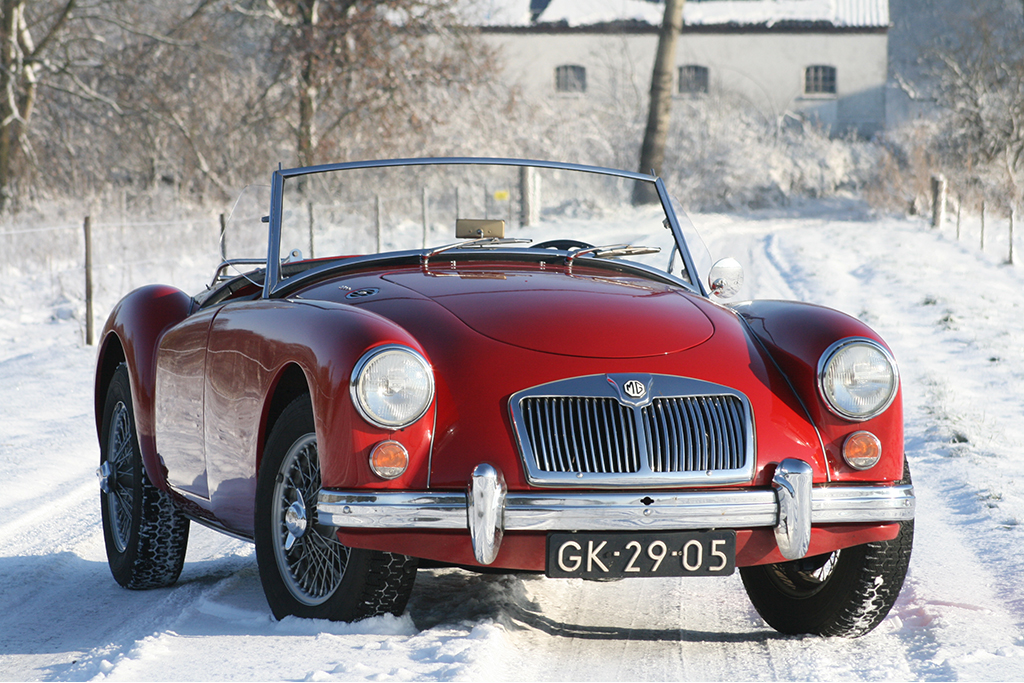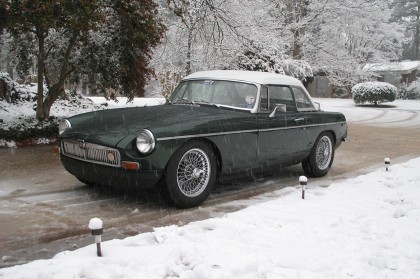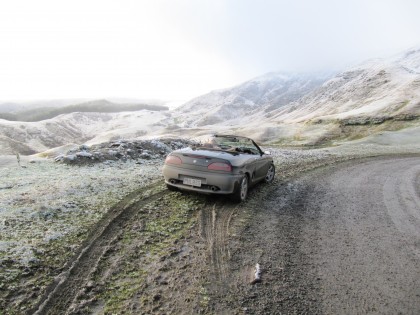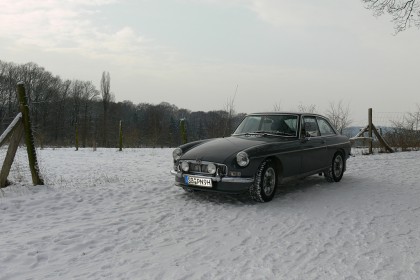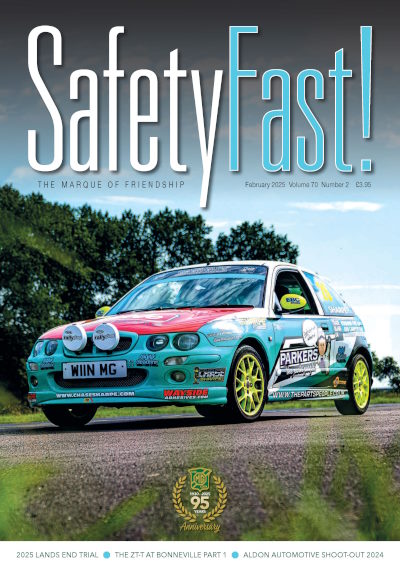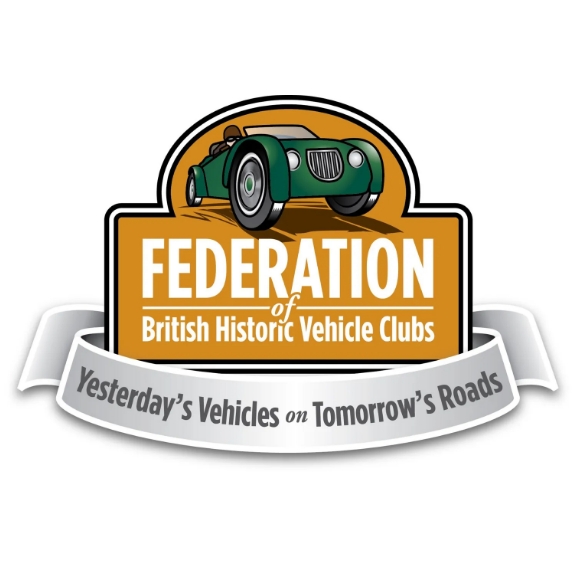Driving in Winter
Reproduction in whole or in part of any article published on this website is prohibited without written permission of The MG Car Club.
With the help of ’on-line advice’ by the RAC, Colin Grant has compiled a list of the most likely hazards you will encounter and how to prepare yourself to cope with them.
Driving in winter can be hazardous, particularly if you are driving an older MG with none of the modern driving aids, such as traction control, anti-lock braking etc. In view of this it’s a good idea to give some thought to how you will cope with the various hazards that you will encounter whilst driving.
Preparation:
Consider the fitting of winter tyres, compulsory in some EU countries, as these will cope better with winter conditions. Make up a winter kit to keep in your car such as a folding shovel, available from Halfords and other car accessory stores, de-icer, scraper, and a blanket. You should also consider on a long trip in poor conditions (only do the trip if really necessary) a flask of coffee and something to eat such as bar of chocolate. Make sure your windscreen wipers are in good condition and renew if in doubt, and fill up your petrol/diesel tank before attempting a long journey. Take out a membership of a motoring organisation such as the RAC and make sure you carry your membership card and a fully charged mobile phone.
Driving in ice conditions
Ice is one of the most hazardous of all driving conditions. Black ice is particularly treacherous because it is transparent and harder to spot compared to snow, frozen slush or thicker white ice. As a result, many drivers often don’t realise they are actually driving on ice and don’t reduce their speeds. Here are some useful tips for driving in ice:
– Only drive if it’s absolutely necessary and don’t be afraid to turn back if you think the conditions are too treacherous
– Make sure you windows are completely clear before you start driving.
– If you’re driving to meet someone, let them know where you are travelling and when you expect to arrive
– You may need to leave as much as 10 times the normal recommended gap between you and the car in front
– If you do encounter a skid, steer gently into it – for example, if the rear of the car is sliding to the right, steer to the right. Do not take your hands off the steering wheel or stamp your foot on the brakes
– Controls such as the brakes, as well as the steering, accelerator and even gear changing should be operated both smoothly and slowly
– A higher gear may be more appropriate to aid the tyres gripping when moving off on packed ice
Driving in Hail
Hail storms are extremely dangerous to drive in. Not only can they cause extensive damage to your car but can also be harmful to anyone who decides to venture out of their vehicle. If you have to travel, plan your route to avoid known affected areas. We also recommend informing relatives and friends of your intended route in case of an emergency. The following tips should always be followed when driving in hail storms:
– Stay inside the vehicle. Hail falls at fast speeds, and can cause injury
– If hail is severe, stop driving and pull over to a safe place so the hail doesn’t break the windshield or any windows. Stop under an overpass if you can, or pull out of traffic lanes and on to a hard shoulder
– Keep your car angled so that the hail is hitting the front of your car. Windshields are reinforced to withstand forward driving and pelting objects. Side windows and backglass are not and are much more susceptible to breakage
Driving In Flooded Areas:
Breakdown numbers always increase during periods of wet weather, as the damp causes problems with engines and electrical systems, particularly in older vehicles
Many rain-related breakdowns are easily avoidable as they are often caused by people driving through deep standing water. While cars have improved significantly in technical terms in recent years they are still not waterproof and will break down if they are driven through deep water. This can lead to catastrophic engine failure which will be extremely expensive to put right.
A catastrophic flood-related engine damage incident is typically caused by water being sucked into the engine which causes the engine to lock up and can in turn damage important engine components including piston connecting rods and valves. This inevitably means a new engine will have to be fitted, but what people generally don’t understand is that it is the owner who is likely to have foot the expensive garage bill unless they can demonstrate to their insurer – like any accident – that it was not their actions that caused the damage.
The following tips should always be followed for driving in flooded conditions:
– Do not attempt to drive through water if you are unsure of the depth – the edge of the kerb is a good indicator
– If you do go through water, drive on the highest section of the road
– Drive steadily and slowly so as not to create a bow wave in front of the vehicle and allow oncoming traffic to pass first – make sure you have a clear route ahead so you do not have to stop in standing water
– Driving at speed may be dangerous to other vehicles or pedestrians and could cause loss of control
– Drive a safe distance from the vehicle in front
– Never attempt to drive through fast flowing water – you could easily get swept away
– Test your brakes after leaving flood water
– If your engine cuts out after driving through deep water, do not attempt to restart as engine damage may occur – instead call for assistance and have the vehicle professionally examined.
Driving in Fog:
Fog dramatically reduces visibility, meaning motorists must reduce their speeds significantly to ensure the roads are safe for both themselves and other users.
Fog lights; The Highway Code states that headlights must be used when visibility is less than 100 metres – roughly the length of a football pitch.
The following tips should always be followed when driving in fog:
– Make sure you know how to operate your front and rear fog lights before setting off. Don’t confuse these with your ‘full-beam’ setting (see below)
– Headlights should be dipped at all times
– Follow the ‘two-second rule’ to leave sufficient space between you and the car in front
– Don’t attempt to navigate using the car in front’s tail lights, as this could lead you to getting too close to them and not leave sufficient stopping distance
– If visibility is very limited, wind down your windows at junctions and crossroads to allow you to listen out for approaching traffic. If you really cannot see, you should consider stopping until it is safe to continue
– Remember to turn your fog lights off as soon as conditions improve
– Consider whether your journey is really necessary – only travel where there is no other option. If you do have to travel, listen out for local news bulletins to keep up to date with road closures.
Driving in strong wind
– Plan your journey – is there a route with less exposure to the weather? Choose a sheltered route if you have the option
– Drive slowly enough to cope with the gusts – high winds can get under a car and affect its handling and braking significantly
– Be prepared when driving in exposed areas, vehicles could be hit by sudden gusts of wind
– Be very careful when overtaking high-sided vehicles – driving past large vehicles can result in a sudden gust from the side as you clear
– Make sure you hold the steering wheel firmly. Strong winds are not constant; they’re usually gusty and can catch you off guard
– Give cyclists, motorcyclists, lorries and buses more room than usual. They get blown around easily by side winds. Motorcyclists especially should avoid travelling in high winds as high cross winds can affect the handling of the motorcycle
– Keep an eye on what is happening to other vehicles. Where they are affected will give you a pre-warning, eg if they appear to be blown off course
– Keep extra distance between you and the car in front – consider increasing the two-second rule to three seconds
– Make sure that you park your car in a safe place – avoid parking under trees, near buildings etc
Be wary of:
– Crossing high exposed bridges
– Vehicles towing caravans
– Using top or roof boxes as this increases susceptibility to cross-winds
– Debris on the road.
Above all drive Safety Fast!

 MG Car Club
MG Car Club